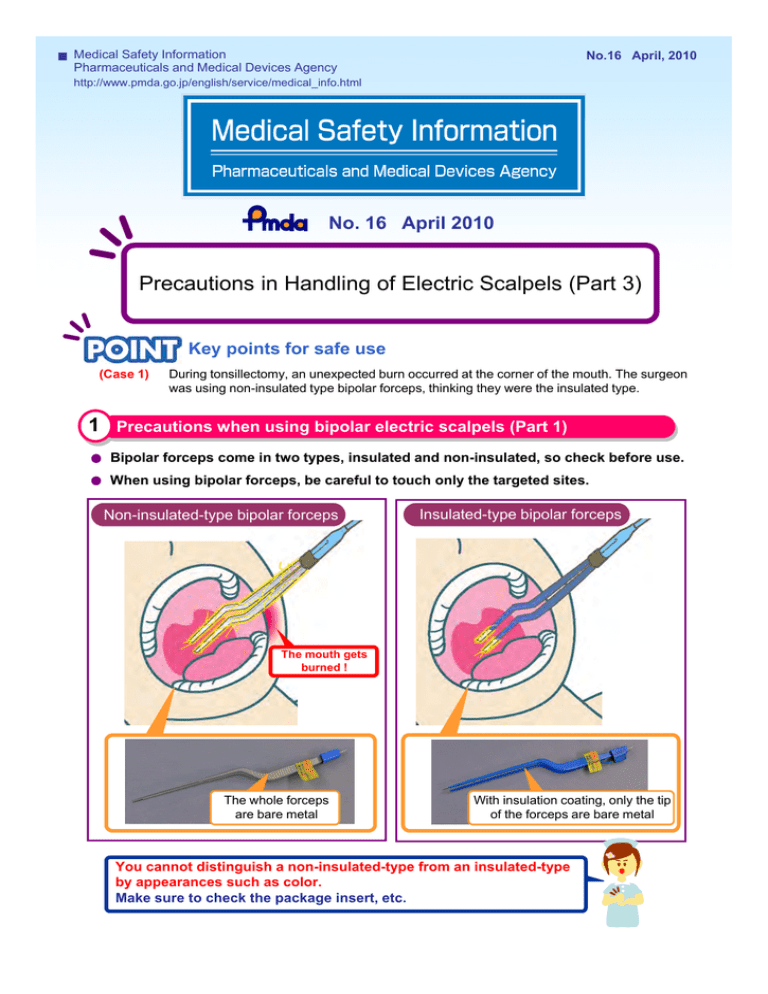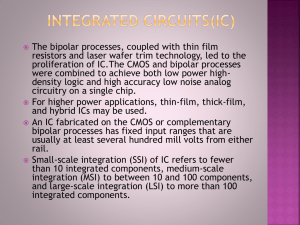Precautions in Handling of Electric Scalpels (Part 3)
advertisement

Medical Safety Information No.16 April, 2010 Pharmaceuticals and Medical Devices Agency http://www.pmda.go.jp/english/service/medical_info.html No. 16 April 2010 Precautions in Handling of Electric Scalpels (Part 3) Key points for safe use (Case 1) During tonsillectomy, an unexpected burn occurred at the corner of the mouth. The surgeon was using non-insulated type bipolar forceps, thinking they were the insulated type. 1 Precautions when using bipolar electric scalpels (Part 1) Bipolar forceps come in two types, insulated and non-insulated, so check before use. When using bipolar forceps, be careful to touch only the targeted sites. 熱傷が発生する原因 Non-insulated-type bipolar forceps Insulated-type bipolar forceps The mouth gets burned ! The whole forceps are bare metal With insulation coating, only the tip of the forceps are bare metal You cannot distinguish a non-insulated-type from an insulated-type by appearances such as color. Make sure to check the package insert, etc. Medical Safety Information No.16 April, 2010 Pharmaceuticals and Medical Devices Agency http://www.pmda.go.jp/english/service/medical_info.html (Case 2) During use of bipolar forceps, an unexpected burn occurred. On close examination, it was found that the bipolar electrode was connected to the monopolar output terminal via the “Flying lead” extension cord. 2 Precautions when using bipolar electric scalpels (Part 2) Since the spacing between the two male connectors of ‘Flying lead’ extension cords are variable, there is a risk that they can erroneously be connected to unintended sites, so please exercise caution. Erroneous connection using “Flying lead” extension cords Electric scalpel’s power supply Monopolar output terminal Erroneous connection of a bipolar electrode to a monopolar output terminal may cause larger current flow than that from a bipolar output terminal which is extremely dangerous. Bipolar output terminal Bipolar electrode ‘Flying-lead’ extension cord (Two male connectors separated type) Some products come with a tag shown on the left which is provided by the manufacturer. Use this to prevent erroneous connections. (Bipolar use only) *This label is indicated in Japanese. 固定形プラグの一例 An example of measures to prevent erroneous connections Bipolar electrode Fixed-plugs Two male connectors fixed type To prevent erroneous connection, we recommend switching from ‘Flying lead’ extension cords to “fixed plugs that are designated for the electric scalpel’s power supply”. against erroneous connection of “Flying lead” extension cords are also on the Japan * Warnings Association of Medical Devices Industries website, at http://www.jamdi.org/anzen/index.html. (in Japanese) Medical Safety Information No.16 April, 2010 Pharmaceuticals and Medical Devices Agency http://www.pmda.go.jp/english/service/medical_info.html (Case 3) A burn at the return electrode site was found after the surgery. The type of electric scalpel that was used had no alarms for return electrode detachment. 3 Precautions when using monopolar electric scalpels In a situation where the return electrode cords get pulled (e.g. while changing the position of the patient, when the operator’s feet get caught in the code), please exercise caution since there is a risk of detachment of return electrodes. Depending on the functions of the electric scalpel’s power supply and the return electrodes, it may not be possible to monitor the attachment status of the return electrodes. No alarm! A return electrode detaches! There is a possibility that there will be no alarms when the return electrode detaches. This depends on the functions of the power supply of the electric scalpel and the return electrodes. Consult the manufacturer to fully understand the functions of the monopolar electric scalpel. The Ministry of Health, Labour, and Welfare (MHLW) has issued notifications that are related to issues in this PMDA Medical Safety Information No. 16: “Self inspections, etc. for electrosurgical devices with bipolar electrodes” (Joint PFSB/ELD Notification No. 0924006 and PFSB/SD 0924004 issued on September 24, 2004) Information on this notification is available at the Pharmaceuticals and Medical Devices Information website (in Japanese) http://www.info.pmda.go.jp (Information related to medical devices > Notification on device safety measures > Notifications on voluntary inspections) About this information * PMDA Medical Safety Information is issued by the Pharmaceuticals and Medical Devices Agency for the purpose of providing healthcare providers with clearer information from the perspective of promoting the safe use of pharmaceuticals and medical devices. The information presented here has been compiled, with the assistance of expert advice, from cases collected as Medical Accident Information Reports by the Japan Council for Quality Health Care, and collected as Adverse Drug Reaction and Malfunction Reports in accordance with the Pharmaceutical Affairs Law. * We have tried to ensure the accuracy of this information at the time of its compilation but do not guarantee its accuracy in the future. * This information is not intended to impose constraints on the discretion of healthcare professionals or to impose obligations and responsibility on them, but is provided as a support to promote the safe use of pharmaceuticals and medical devices by healthcare professionals.






